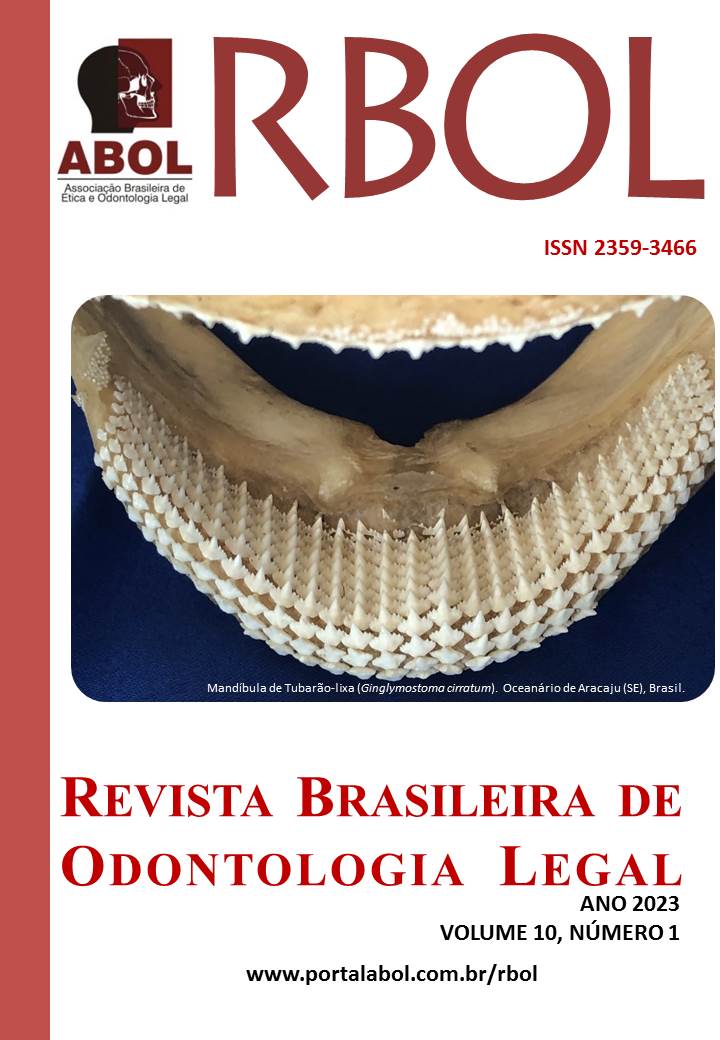INTRAORAL SCANNING AS A TOOL FOR IDENTIFICATION THROUGH PALATAL ROUGHNESS
DOI:
https://doi.org/10.21117/rbol-v10n12023-466Keywords:
Palatal, Human identification, Forensic dentistryAbstract
The palatal rugoscopy analyzes the patterns of wrinkles and their unique characteristics for each individual, and assists forensic odontology in human identification. Despite being an old method, there are still few studies on its digitalization. Among the various technological advances that have grown in dentistry in recent years, its possible to mention that the intraoral scanning, which was used in this study as a tool for human identification through palatal wrinkles, since it is increasingly present in dentistry and is available in digital medical records. Thus, new identification techniques should be developed to follow this evolution, such as rugoscopy, which originally analyzed plaster models, can be replaced by a 100% digital method using the intraoral scanner associated with software for visualization and analyzation of wrinkles. The purpose of this study was to verify the feasibility of the digital method of palatal rugoscopy and suggesting its use in forensic dentistry. Thirty students enrolled in dentistry course at Universidade São Francisco in Bragança Paulista/SP participated in this study. The volunteers took an intraoral scan of the upper arch using the TRIOS® 3 Basic intraoral scanner from 3Shape. Subsequently, the digital models were exported to Blender® software to analyze and classify the palatal wrinkles. By comparing and superimposing the models, the examiner obtained a result of 100% correct, proving to be a useful, reliable and accurate method.
Downloads
Published
Issue
Section
License
Os autores deverão encaminhar por email, devidamente assinada pelos autores ou pelo autor responsável pelo trabalho, a declaração de responsabilidade e transferência de direitos autorais para a RBOL, conforme modelo abaixo.
DECLARAÇÃO DE RESPONSABILIDADE E TRANSFERÊNCIA DE DIREITOS AUTORAIS
Eu (Nós), listar os nomes completos dos autores, transfiro(rimos) todos os direitos autorais do artigo intitulado: colocar o título à Revista Brasileira de Odontologia Legal - RBOL.
Declaro(amos) que o trabalho mencionado é original, não é resultante de plágio, que não foi publicado e não está sendo considerado para publicação em outra revista, quer seja no formato impresso ou no eletrônico.
Declaro(amos) que o presente trabalho não apresenta conflitos de interesse pessoais, empresariais ou governamentais que poderiam comprometer a obtenção e divulgação dos resultados bem como a discussão e conclusão do estudo.
Declaro(amos) que o presente trabalho foi totalmente custeado por seus autores. Em caso de financiamento, identificar qual a empresa, governo ou agência financiadora.
Local, data, mês e ano.
Nome e assinatura do autor responsável (ou de todos os autores).

